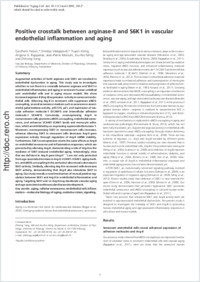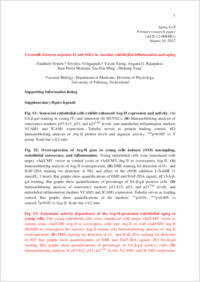Positive crosstalk between arginase-II and S6K1 in vascular endothelial inflammation and aging
- Yepuri, Gautham Vascular Biology, Department of Medicine, Division of Physiology, University of Fribourg, Switzerland
- Velagapudi, Srividya Vascular Biology, Department of Medicine, Division of Physiology, University of Fribourg, Switzerland
- Xiong, Yuyan Vascular Biology, Department of Medicine, Division of Physiology, University of Fribourg, Switzerland
- Rajapakse, Angana G. Vascular Biology, Department of Medicine, Division of Physiology, University of Fribourg, Switzerland
- Montani, Jean-Pierre Vascular Biology, Department of Medicine, Division of Physiology, University of Fribourg, Switzerland
- Ming, Xiu-Fen Vascular Biology, Department of Medicine, Division of Physiology, University of Fribourg, Switzerland
- Yang, Zhihong Vascular Biology, Department of Medicine, Division of Physiology, University of Fribourg, Switzerland
-
18.09.2012
Published in:
- Aging Cell. - 2012, vol. 11, no. 6, p. 1005-1016
Aging
Cellular senescence
Endothelial cell
Inflammation – molecular biology of aging
Oxidative stress
Signaling
English
Augmented activities of both arginase and S6K1 are involved in endothelial dysfunction in aging. This study was to investigate whether or not there is a crosstalk between arginase and S6K1 in endothelial inflammation and aging in senescent human umbilical vein endothelial cells and in aging mouse models. We show increased arginase-II (Arg-II) expression/activity in senescent endothelial cells. Silencing Arg-II in senescent cells suppresses eNOS-uncoupling, several senescence markers such as senescence-associated-β-galactosidase activity, p53-S15, p21, and expression of vascular adhesion molecule-1 (VCAM1) and intercellular adhesion molecule-1 (ICAM1). Conversely, overexpressing Arg-II in nonsenescent cells promotes eNOS-uncoupling, endothelial senescence, and enhances VCAM1/ICAM1 levels and monocyte adhesion, which are inhibited by co-expressing superoxide dismutase-1. Moreover, overexpressing S6K1 in nonsenescent cells increases, whereas silencing S6K1 in senescent cells decreases Arg-II gene expression/activity through regulation of Arg-II mRNA stability. Furthermore, S6K1 overexpression exerts the same effects as Arg-II on endothelial senescence and inflammation responses, which are prevented by silencing Arg-II, demonstrating a role of Arg-II as the mediator of S6K1-induced endothelial aging. Interestingly, mice that are deficient in Arg-II gene (Arg-II−/−) are not only protected from age-associated increase in Arg-II, VCAM1/ICAM1, aging markers, and eNOS-uncoupling in the aortas but also reveal a decrease in S6K1 activity. Similarly, silencing Arg-II in senescent cells decreases S6K1 activity, demonstrating that Arg-II also stimulates S6K1 in aging. Our study reveals a novel mechanism of mutual positive regulation between S6K1 and Arg-II in endothelial inflammation and aging. Targeting S6K1 and/or Arg-II may decelerate vascular aging and age-associated cardiovascular disease development.
- Faculty
- Faculté des sciences et de médecine
- Department
- Département de Médecine
- Language
-
- English
- Classification
- Biological sciences
- License
- License undefined
- Identifiers
-
- RERO DOC 30522
- DOI 10.1111/acel.12001
- Persistent URL
- https://folia.unifr.ch/unifr/documents/302605
Other files
Statistics
Document views: 84
File downloads:
- yan_pcb.pdf: 202
- yan_pcb_sm.pdf: 119

